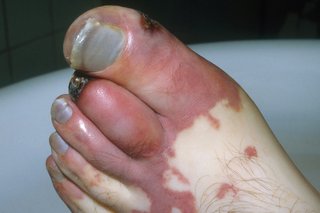The symptoms of gangrene vary depending on the underlying cause. It can affect any part of the body, but typically starts in the toes, feet, fingers or hands.
General symptoms of gangrene include:
- red, purple or black skin in the affected area, which may be harder to see on black or brown skin
- swelling of the affected area
- either a loss of sensation or severe pain in the affected area
- sores or blisters that bleed or release a dirty-looking or foul-smelling discharge (if the gangrene is caused by an infection)

In some cases, the affected limb may feel heavy and pressing the skin may produce a crackling sound. These symptoms are caused by a build-up of gas under the skin.
If the area is infected, you may also have other signs related to the underlying infection, such as:
- a high temperature of 38C or above
- feeling hot and shivery
Without treatment the affected tissue will start to die. When this happens, the area changes colour from red to brown to purple or black, before shrivelling up and falling away from the surrounding healthy tissue.
When to seek medical advice
The earlier treatment for gangrene begins, the more effective it's likely to be. Contact your GP immediately if you have:
- any of the symptoms of gangrene mentioned above
- a persistent fever
- a wound that's unusually slow to heal
If your GP isn't available, call NHS 111 or your local NHS out-of-hours service for advice.
When to seek emergency help
If bacteria from gangrene pass into your bloodstream, you could go into septic shock (sepsis). This is a life-threatening condition that occurs when an infection causes your blood pressure to drop to a dangerously low level.
Signs of septic shock include:
- a rapid but weak pulse
- dizziness when you stand up
- a change in your mental state, such as confusion or disorientation
- breathing difficulties
- vomiting
- diarrhoea
- cold, clammy and paler than usual skin
Dial 999 immediately to request an ambulance if you suspect that you or someone you know is in septic shock.
Page last reviewed: 29 September 2022
Next review due: 29 September 2025